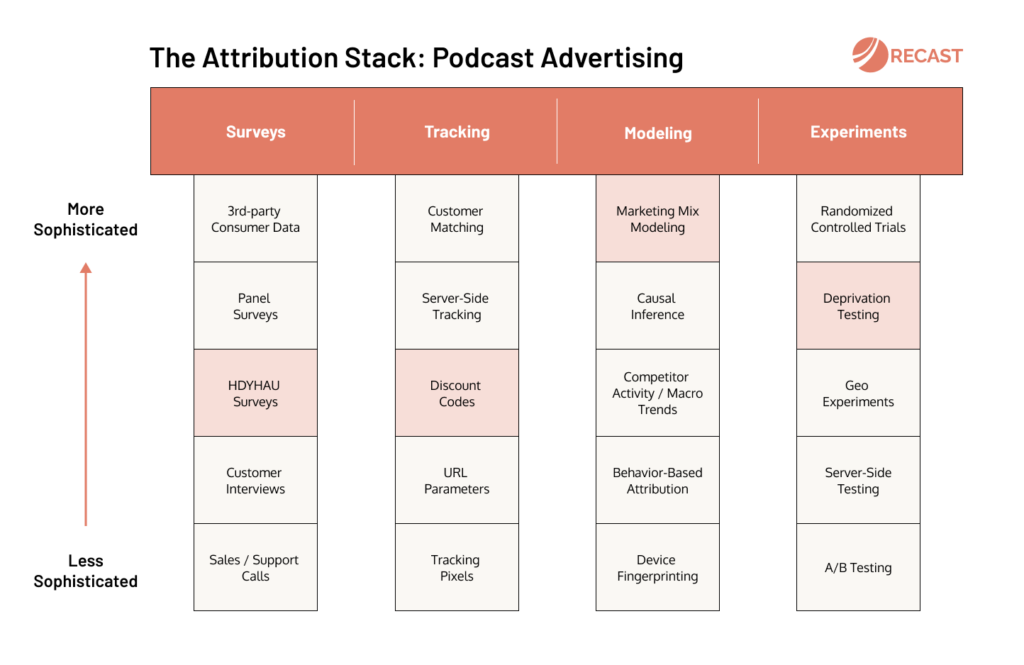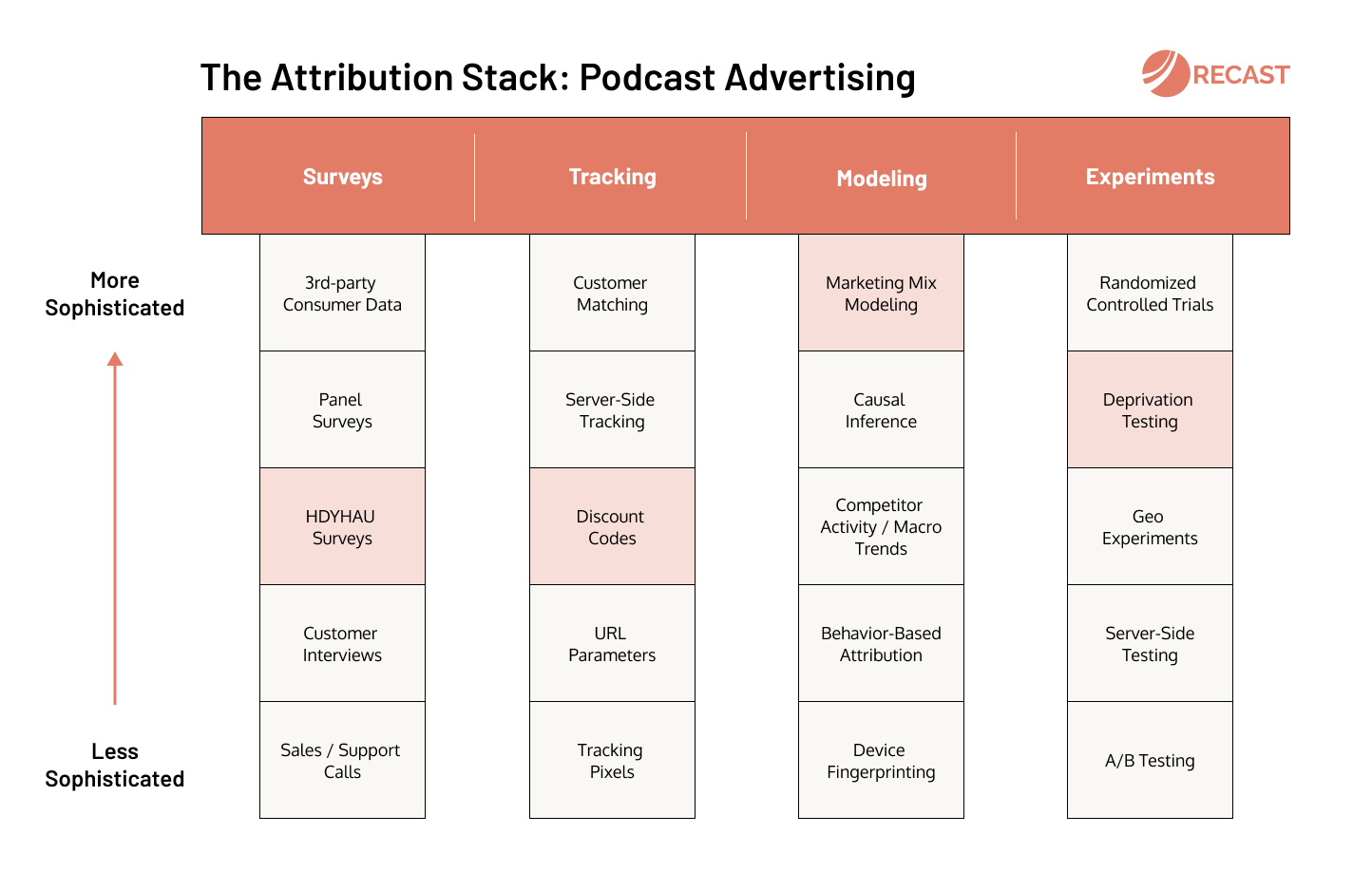Podcast advertising is a form of digital advertising that allows companies to place ads in podcasts. This type of advertising can be used to target a specific audience, and it can be an effective way to reach potential customers who are interested in the topics covered in the podcast.
Podcast advertising is an important part of the marketing mix because it allows businesses to reach consumers while they are commuting, working out, or doing other activities with long dwell time. Podcasts allow businesses to target specific demographics, such as young adults or parents, who may be harder to reach via other means. According to WARC’s 2019 Global Ad Trends report, podcast ad spend is currently worth $855m globally, though that is less than 5% of total audio advertising spend.
Measurement of Podcast advertising is a challenge, given there’s no way to “click” on a Podcast ad, nor measure who listened to it before making a purchase. Instead marketers must rely on less granular survey or experiment-based methods, which can be difficult to set up and run effectively. However as Podcast advertising is a relatively untapped channel, investments in better measurement are likely to pay off in lower advertising costs.

1. Discount Codes
This is a technique that has worked forever: Claude Hopkins advocated for it in his book “Scientific Advertising”, published way back in 1923! Each podcast you sponsor gets their own unique code (and maybe unique URL / landing page), which will give them a small discount and potentially extra benefits for purchasing your product.
There are well documented issues with promo codes, for example affiliates like Honey automatically finding and inserting codes at checkout, or savvy customers who don’t buy before searching [brand name] + promo code. Also many people just simply forget to input the code when purchasing, or it has expired by the time they listen to the episode. Additionally, the cost of the discount or bonus feature eats into your margin, making the channel less efficient overall (since you’re paying just to be able to track customers).
However an imperfect method is better than no method, so the mighty promo code persists.

2. HDYHAU Surveys
One of the easiest ways to measure your Podcast ads performance, is simply to ask your customers: “How Did You Hear About Us?”. These are called “HDYHAU” surveys, and they are usually placed at the end of a checkout or signup process, so as to not get in the way of the user converting. This method biases towards more memorable channels, which makes it great for measuring Podcasts, and doesn’t require any sophisticated tracking. Memories aren’t always reliable however, so don’t make this the only method you use.

3. Deprivation Testing
The simplest but potentially least granular way to test something: switch it off, switch it back on again. In practical terms what that means for Podcast advertisers is to just note down what days they’re going live on a Podcast, and whether they see a spike in website traffic and conversions. To make it more robust, you can scale your spend up and down in order to tell a qualitative difference between different spend levels. This is all back of the napkin stuff, because just because you stopped showing up on podcasts, doesn’t mean there won’t be a tail end of traffic from people listening to older episodes.

4. Marketing Mix Modeling
Incorporating Podcast ads into your Marketing Mix Model is important if it’s a significant part of your budget. It’s also one of the harder channels to measure, so make sure you’re working with an expert who can get it right. At Recast we’ve found splitting the spend into “Tests” and “Renewals” works well, because many of the podcasts tested fail to move the needle.
One practical consideration is the data you can use. Typically Podcast campaigns report metrics such as downloads or total audience size, due to limitations of the medium. Sometimes you can get impressions based on server side tracking of when ads were listened to, but it depends on the network you’re using. At Recast we prefer to model spend and line it up to publish dates, because as with all channels, what matters is how much money you made for each incremental dollar spent.
The long term or lagged effect of Podcasts, sometimes called ‘adstocks’ in by MMM practitioners, is key to modeling this channel correctly. People listen to Podcasts in some cases months after downloading, so there’s an outsized impact on medium and long term performance in this channel relative to others. Whatever MMM tool, library, or vendor you use must find the correct adstock parameters to account for the true incremental value over time.

How To Measure Anything
Don’t let the difficulties of measuring Podcast advertising, or any other channel, limit your marketing strategy. Finding creative ways to measure the impact of hard to measure channels can give you an unfair advantage against the competition. If you can advertise places your competitors can’t, you can enjoy much cheaper advertising costs, and more effective marketing campaigns.
This post is part of the “How to Measure Anything” series, which covers which attribution methods from “The Attribution Stack” are best for measuring the incrementality of each major marketing channel. At Recast we’re trying to rid the World of wasted ad spend, and if you could use a hand measuring marketing effectiveness, we’d love to hear from you.



